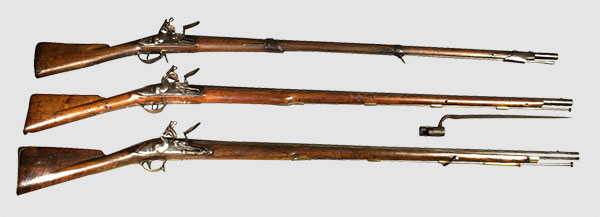

Flintlock Musket (top)
French
1774 – 1777
Barrel .69/100 caliber
Wood, iron, steel. L 152.2 (barrel L 113.7) cm
George C. Neumann Collection
Valley Forge National Historical Park, VAFO 124
Infantry Musket (middle)
GermanA large number of German muskets were used by "Hessian" soldiers hired by the English Crown to fight the American Colonies. German muskets were also captured or confiscated from royal armories by the Americans early in the war. While these muskets varied greatly depending upon where they were manufactured in the various German states, all shared a heavy, well-built stock, brass components, and a large oval front sight.
Barrel .75 to .81/100 caliber
Wood, brass. L 146.4 cm
George C. Neumann Collection
Valley Forge National Historical Park, VAFO 127
Socket Bayonet
1777 – 1783Iron. L 43.9 (blade L 36.1), W 2 cm
The George C. Neumann Collection,
Valley Forge National Historical Park, VAFO 709
Short Land Service Musket (bottom)
English1765 – 1775
Commonly referred to as the second model "Brown Bess" musket, the short land service musket became the standard shoulder weapon of England's land forces in 1768. This musket is stamped on the lockplate with the typical English crown over "GR" and "Tower," signifying the primary proofhouse in the Tower of London. "GR" stands for Georgius Rex, Latin for King George III.
Barrel .78/100 caliber. Weight 10.3lbs
Walnut, brass. L 146.7, (barrel L 106.7), (lock L 17.8),
W 4.75 cm
George C. Neumann Collection
Valley Forge National Historical Park, VAFO 109